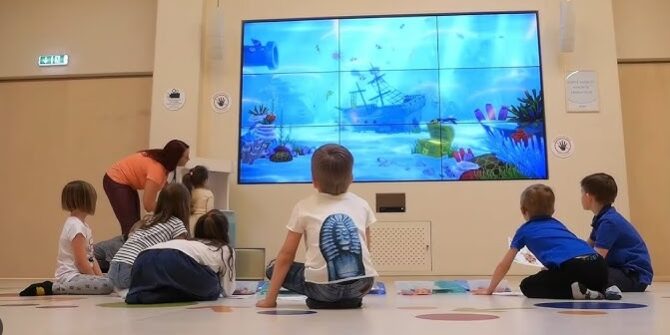What is POE LiDAR?
POE LiDAR (Power Over Ethernet Light Detection and Ranging) is a cutting-edge technology that uses laser pulses to create precise 3D spatial maps. By capturing movements in real time, it enables touchless interaction with digital content. Unlike traditional touchscreens or projectors, POE LiDAR offers unparalleled versatility, accuracy, and scalability, making it a game-changer for educational environments.

The Advantages of POE LiDAR in Interactive Projections
1. Touch-Free and Hygienic Interaction
POE LiDAR enables students to engage with digital content through gestures, eliminating the need for physical touch. This feature is particularly valuable for maintaining hygiene in shared learning environments.
2. Adaptable to Any Surface
From walls to floors and tables, POE LiDAR transforms any surface into an interactive medium, making classrooms more dynamic and versatile.
3. Enhanced Engagement with Multi-Touch Support
With the ability to detect up to 255 touch points simultaneously, POE LiDAR allows group activities and collaborative learning without limitations.
4. Scalable for Any Space
Whether it’s a small classroom or a large lecture hall, POE LiDAR adapts to various spaces with an interaction radius of up to 70 meters.
5. Seamless Software Integration
POE LiDAR systems easily integrate with third-party educational software, offering endless customization for different learning needs.
How POE LiDAR is Revolutionizing Interactive Education
Interactive Sandboxes for Kids
POE LiDAR brings geography and creativity to life through digital sandboxes. Children can shape and reshape sand to create landscapes, rivers, and mountains, while the LiDAR system projects real-time changes, making lessons immersive and fun.
Interactive Slides for Play and Learning
Imagine children sliding down a playground slide while interacting with projected games or educational content. POE LiDAR transforms this activity into an engaging blend of physical activity and cognitive learning.
Interactive Sports and Games
Interactive floor projections powered by POE LiDAR can turn gym floors into dynamic sports arenas or digital playgrounds. Games like hopscotch or soccer become educational as children solve puzzles or learn math while playing.
Digital Education for Children
LiDAR-based systems transform traditional teaching into digital, hands-on experiences. Examples include:
- Science Simulations: Kids can interact with 3D models of atoms, ecosystems, or planets.
- Mathematics: Children solve problems by physically arranging or interacting with digital objects.
- Art: Virtual canvases enable kids to paint or sculpt in 3D.
Why POE LiDAR is Perfect for Educational Institutions
- Personalized Learning
AI-driven POE LiDAR systems adapt to students’ learning speeds and styles, offering customized content and instant feedback for educators. - Inclusive Education
POE LiDAR can convert complex visual or textual lessons into tactile, interactive 3D experiences, making them accessible for students with disabilities. - Risk-Free Practice
LiDAR-enabled simulations allow students to practice real-world scenarios—like performing surgeries, building models, or conducting experiments—without real-life risks. - Gamified Learning
By turning lessons into interactive games, POE LiDAR ensures that learning is fun and engaging, especially for younger children.
Conclusion: The Future of Education with POE LiDAR
POE LiDAR interactive projection technology is setting a new standard for educational innovation. By integrating dynamic, touchless, and immersive interactions into classrooms, this technology caters to diverse learning styles, enhances student engagement, and prepares them for a future driven by technology.
Whether it’s through interactive sandboxes, digital slides, or gamified lessons, POE LiDAR is making learning more exciting, inclusive, and effective. Educational institutions looking to transform their learning environments should consider the immense potential of POE LiDAR.
The classroom of tomorrow is here—powered by POE LiDAR!







